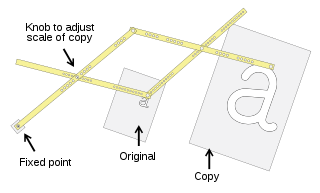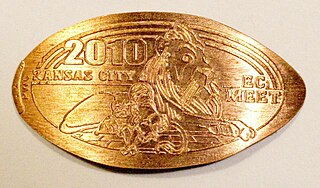
A pantograph is a mechanical linkage connected in a manner based on parallelograms so that the movement of one pen, in tracing an image, produces identical movements in a second pen. If a line drawing is traced by the first point, an identical, enlarged, or miniaturized copy will be drawn by a pen fixed to the other. Using the same principle, different kinds of pantographs are used for other forms of duplication in areas such as sculpture, minting, engraving, and milling.

Engraving is the practice of incising a design onto a hard, usually flat surface by cutting grooves into it with a burin. The result may be a decorated object in itself, as when silver, gold, steel, or glass are engraved, or may provide an intaglio printing plate, of copper or another metal, for printing images on paper as prints or illustrations; these images are also called "engravings". Engraving is one of the oldest and most important techniques in printmaking. Wood engraving is a form of relief printing and is not covered in this article.

The British penny, a large, pre-decimal coin which continued the series of pennies which began in about the year 700, was struck intermittently during the 20th century until its withdrawal from circulation after 1970. From 1901 to 1970, the obverse of the bronze coin depicted the monarch who was reigning at the start of the year. The reverse, which featured an image of Britannia seated with shield, trident, and helm, was created by Leonard Charles Wyon based on an earlier design by his father, William Wyon. The coins were also used in British colonies and dominions that had not issued their own coins.

The Bureau of Engraving and Printing (BEP) is a government agency within the United States Department of the Treasury that designs and produces a variety of security products for the United States government, most notable of which is Federal Reserve Notes for the Federal Reserve, the nation's central bank. In addition to paper currency, the BEP produces Treasury securities; military commissions and award certificates; invitations and admission cards; and many different types of identification cards, forms, and other special security documents for a variety of government agencies. The BEP does not produce coins; all coinage is produced by the United States Mint. With production facilities in Washington, D.C., and Fort Worth, Texas, the Bureau of Engraving and Printing is the largest producer of government security documents in the United States.

Benedetto Pistrucci was an Italian gem-engraver, medallist and coin engraver, probably best known for his Saint George and the Dragon design for the British sovereign coin. Pistrucci was commissioned by the British government to create the large Waterloo Medal, a project which took him thirty years to complete.

The Royal Mint is the United Kingdom's oldest company and the official maker of British coins.

A nickel is a five-cent coin struck by the United States Mint. Composed of cupronickel, the piece has been issued since 1866. Its diameter is 0.835 inches (21.21 mm) and its thickness is 0.077 inches (1.95 mm).

An elongated coin is one that has been flattened or stretched, and embossed with a new design. Such coins are often used as commemorative or souvenir tokens, and it is common to find coin elongation machines in tourism hubs, such as museums, amusement parks, and natural or man-made landmarks.

Christian Gobrecht was the third Chief Engraver of the United States Mint from 1840 until his death in 1844. He was responsible for designing the famous "Seated Liberty" designs, which were in turn the direct inspiration for the design of the Trade Dollar. He designed the Gobrecht Dollar, which was struck in small quantities from 1836 to 1838 and later inspired the Flying Eagle cent. He also designed the obverse sides for the Liberty head Quarter Eagle, Half Eagle, and Eagle gold coins, as well as the "braided hair" type Half cent and Large cent coins.

The Seated Liberty dollar was a dollar coin struck by the United States Mint from 1840 to 1873 and designed by its chief engraver, Christian Gobrecht. It was the last silver coin of that denomination to be struck before passage of the Coinage Act of 1873, which temporarily ended production of the silver dollar for American commerce. The coin's obverse is based on that of the Gobrecht dollar, which had been minted experimentally from 1836 to 1839. However, the soaring eagle used on the reverse of the Gobrecht dollar was not used; instead, the United States Mint (Mint) used a heraldic eagle, based on a design by late Mint Chief Engraver John Reich first utilized on coins in 1807.

The Walking Liberty half dollar is a silver 50-cent piece or half dollar coin that was issued by the United States Mint from 1916 to 1947; it was designed by Adolph A. Weinman, a well-known sculptor and engraver.

A medalist is an artist who designs medals, plaquettes, badges, metal medallions, coins and similar small works in relief in metal. Historically, medalists were typically also involved in producing their designs, and were usually either sculptors or goldsmiths by background. In modern times, medalists are mostly primarily sculptors of larger works, but in the past the number of medals and coins produced were sufficient to support specialists who spent most of their career producing them. From the 19th century, the education of a medalist often began with time as an engraver, or a formal education in an academy, particularly modeling and portraiture. On coins, a mark or symbol signifying the medalist as the original designer was often included in a hidden location and is not to be mistaken for the symbol of the mint master. Artistic medals and plaquettes are often signed prominently by the artist.

Roller printing, also called cylinder printing or machine printing, on fabrics is a textile printing process patented by Thomas Bell of Scotland in 1783 in an attempt to reduce the cost of the earlier copperplate printing. This method was used in Lancashire fabric mills to produce cotton dress fabrics from the 1790s, most often reproducing small monochrome patterns characterized by striped motifs and tiny dotted patterns called "machine grounds".
Thomas Shingles was the Master Engraver of the Royal Canadian Mint from 1943 until his retirement in 1965; he first began work at the Mint in 1939. He was born in Birmingham, England.
Minting, coining or coinage is the process of manufacturing coins using a kind of stamping, the process used in both hammered coinage and milled coinage. This "stamping" process is different from the method used in cast coinage.

Leonard Charles Wyon was a British engraver of the Victorian era most notable for his work on the gold and silver coinage struck for the Golden Jubilee of Queen Victoria in 1887 and the bronze coinage of 1860 with the second ("bun") head portrait, in use from 1860 to 1894.

The Lincoln cent is a one-cent coin that has been struck by the United States Mint since 1909. The obverse or heads side was designed by Victor David Brenner, as was the original reverse, depicting two stalks of wheat. The coin has seen several reverse, or tails, designs and now bears one by Lyndall Bass depicting a Union shield. All coins struck by the United States government with a value of 1⁄100 of a dollar are called cents because the United States has always minted coins using decimals. The penny nickname is a carryover from the coins struck in England, which went to decimals for coins in 1971.

James Barton Longacre was an American portraitist and engraver, and the fourth Chief Engraver of the United States Mint from 1844 until his death. Longacre is best known for designing the Indian Head cent, which entered commerce in 1859, and for the designs of the Shield nickel, Flying Eagle cent and other coins of the mid-19th century.

Anton Hám was a Slovak engraver and medallist. He was born and died in the town of Kremnica.
Victor Janvier (1851–1911) was a French sculptor and engraver notable for inventing the Janvier Reducing Machine, a type of lathe which improved the die making process within mints.

















